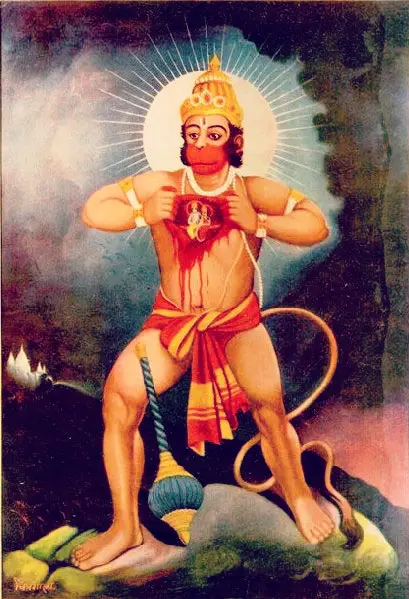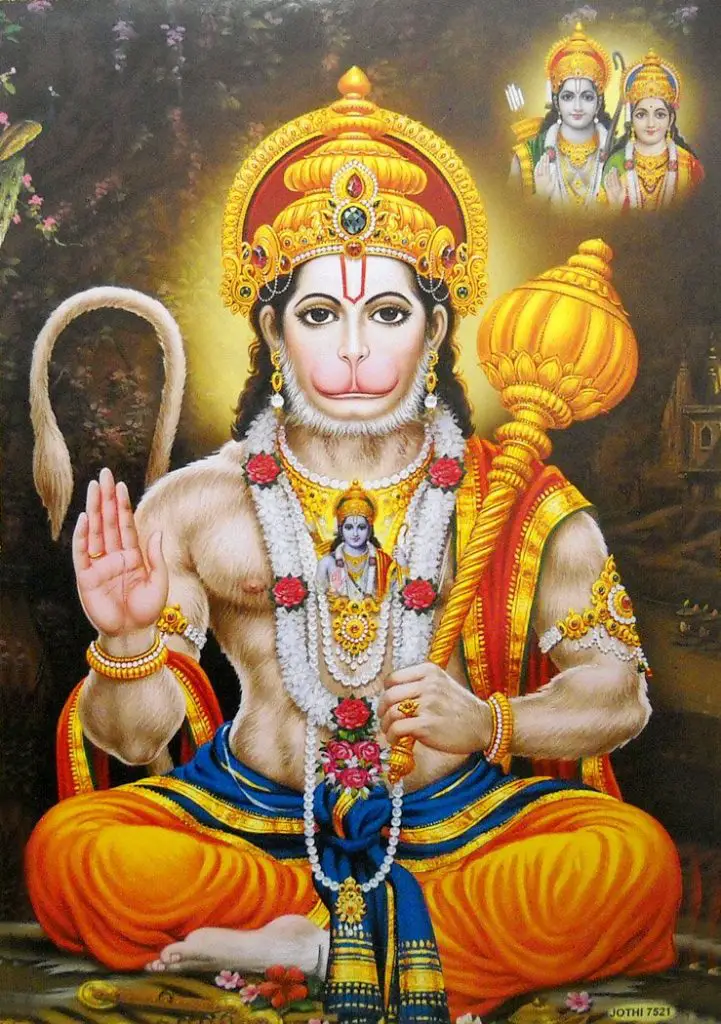Indian Symbol of power, strength, bravery, devotion, and perseverance
Hanuman, according to Hindu tradition, was the Lord of Celibacy, who was a devotee of Rama and the first Avatar of Vayu, the wind god. Hanuman was considered a Brahmachari who was a person on the path of Brahma. Hanuman has monkey traits.
Kesari, who was a Vanara and a chief, was Hanuman’s father, and Anjana, an apsaras, was Hanuman’s mother. Hanuman’s spiritual father was Vayu. When Anjana was pregnant with Hanuman, she received a bit of some sacred pudding from Vayu that was meant for King Dasharasha, who wanted a male child. Because Anjana consumed the sacred pudding, Hanuman was born. Another version of Hanuman’s birth has Vayu and Anjana, who is in the shape of a monkey, as Hanuman’s parents. Another version states that Shiva and Parvati turn themselves into monkeys and produce Hanuman. Shiva directs Vayu to put the embryo into Anjana, and she gives birth to him.

When he was a child, Hanuman was restless and inquisitive. Hanuman mistook the sun for fruit. When he tried to grab it, the guardian deity Indra stopped him by throwing a bolt of lightning at Hanuman and hitting him square on the jaw. This killed Hanuman, and Vayu was depressed. Vayu withdrew from the world and took the wind with him. Shiva, a supreme being, took pity on Vayu and resurrected Hanuman. Vayu came back to the world, and Hanuman was gifted items from different deities. The god Agni bestowed his gift – the fire would never harm Hanuman. Indra granted him this wish – Hanuman’s body would be as strong as a thunderbolt. Vayu’s gift was this – Hanuman would be as swift as the wind. God Varuna granted him this wish – that water would not harm him. Lord Brahma bestowed this gift to Hanuman – that he could change his size and become as big or small as he wanted to. Lord Vishnu also bestowed a weapon to Hanuman named Gada, which was a mace. All of these gifts combined to make Hanuman immortal. Once he had these gifts, Hanuman became mischievous. He would douse sacred fires and pull on the beards of sages. These gifts lasted until Hanuman pranked a meditating sage. The sage was so angry he put a curse on Hanuman, which made Hanuman forget most of his powerful gifts.
In his adult life, Hanuman goes on a quest with the great bear Jambavan to find Rama’s wife, who is missing. Hanuman and Jambavan were told to go to Lanka to find Rama’s missing wife, but neither could swim across the ocean or jump to the island. Jambavan remembered Hanuman’s powers and realized Hanuman had been cursed. Jambavan lifted the curse and gave Hanuman back his powers. With his restored powers, Hanuman found Sita, Rama’s wife. Ravana had kidnapped Sita. Hanuman offers to rescue her, but Sita says Rama must rescue her. Hanuman ends up being captured by Ravana. Ravana does not believe that Rama is coming to rescue his wife. Ravana decides to set Hanuman’s tail on fire. First, Hanuman makes his tail longer and longer, so it takes too much time to douse it in oil. Once Ravana tells his guards to light Hanuman’s tail, Hanuman shrinks it down. He uses his strength to break his chains and escape through a window. He goes from building to building and sets them on fire with his lit tail. Once he was done setting fire to Lanka, Hanuman rested his tail in the ocean to cool down. A drop of his sweat went into the ocean and was swallowed by a great fish, and the fish then gave birth to His son. After he cooled down his tail, he went back to India. When Hanuman returned, he told Rama what had happened, and Rama gathered his forces and marched on Lanka, thus starting the Battle of Lanka.
When the battle began, Hanuman was a general in Rama’s army. Rama was wounded and needed a certain herb to help keep him alive. Hanuman went to get the herb from a Himalayan mountain. He could not figure out which herb was needed, so he got as big as a mountain, tore the mountain from the ground, and took it back to the battle. Rama ended up winning the battle and gave Hanuman the gift of immortality.
At one point, Hanuman asks Sita why she puts sindoor on her forehead. Upon learning that Sindoor shows ultimate love and respect, Hanuman covers himself with Sindoor to show his respect and love for Rama.
Hanuman was written about in the Ramayana, the Mahabharata, the Skanda Purana, and Shiva Purana. Hanuman pleased the Goddess Kahli, and she made him a gatekeeper. He is now portrayed on one side of the entrance to Kahli’s temples. Hanuman is also found in Buddhist texts. The Jain texts state that Hanuman was a supernatural being from the start. In Sikhism, Hanuman was worshiped, and warriors carried his likeness into battle. They also reject the fact that the Hanuman is divine.

Hanuman was considered a cultural icon in India’s colonial and post-colonial eras. Religious and political organizations have named themselves after Hanuman. People dress up as Hanuman for political parades, and Hanuman has become the symbol of religious freedom. There are many temples and shrines dedicated to Hanuman, the earliest being from 922 CE.
The Ramlila celebration in India has Hanuman as a central character. In Cambodia and other parts of Asia, a mask dance dedicated to Hanuman and theatre arts tells about Hanuman’s accomplishments.
There have been movies made of Hanuman and his accomplishments. The Bal Hanuman series ran from 2006-2012. Hanuman was mentioned in the movie Black Panther, which was released in 2018, but all references to him were removed for the Indian versions of the movie.
Amulets devoted to Hanuman are said to protect the wearer against bad magic and give them protection and strength.
Symbols Menu:» Amulet
» Ajna
» Arsenic
» Merkaba
» Hung
» Yin Yang
» bindi
» IK Onkar
» Khanda
» Halo
» jiahu
» Tau
» Uraeus
» Menorah
» Quincunx
» Tilaka
» Taijitu
» Vajra
» Chai
» Chi Rho
» Bagua
» Dragon
» Hunab Ku
» Caduceus
» Infinity
» Ichthus
» Hedjet
» Lauburu
» Om
» Ankh
» Chalice
» Pentacle
» Maat
» Ogham
» Mandala
» Kartika
» Khamsa
» Heart
» Labrys
» Sun Face
» Raven
» Triskele
» Scarab
» Dove
» Hanukia
» Anubis
» Trishula
» Durga
» Mezuzah
» Bay Tree
» Geruda
» Kinnara
» Quito
» Condor
» Blue Jay
» Falcon
» Makara
» Rosary
» Uluru
» Apsaras
» Hanuman
» Serpent
» Minotaur
» Mercury
» Apex
» Vestra
» Yoni
» Astarte
» dakini
» Calabash
» Mandrake
» Rebis
» Typhon
» Vegvísir
